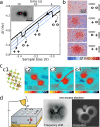Probing Molecular Properties at Atomic Length Scale Using Charge-State Control
- PMID: 40455944
- PMCID: PMC12203467
- DOI: 10.1021/acs.chemrev.4c00899
Probing Molecular Properties at Atomic Length Scale Using Charge-State Control
Abstract
The charge state plays a critical role in governing the structural, electronic, and chemical properties of molecules. Controlling the charge state of individual molecules provides a powerful tool for exploring fundamental processes, such as redox reactions, selective bond rearrangements, molecular excitations, charge transfer, and modulation of reaction pathways at the single-molecule level. Recent advancements in scanning tunneling microscopy (STM) and atomic force microscopy (AFM) have enabled precise and stable manipulation of molecular charge states, allowing for detailed, high-resolution studies of charge-state-dependent phenomena. In this review, we discuss the principles and methodologies for charge-state control in STM and AFM, with a focus on strategies for stabilizing charge states in a controlled experimental environment. We also examine key advancements in the ability to detect and manipulate intra- and intermolecular charge transfer, providing insights into charge-mediated processes, such as structural rearrangements, electronic states, and reactivity at the atomic scale. Finally, we highlight the potential of charge-state control to probe electronic excited states and resolve spin-coherence in individual molecules.
Figures










References
Publication types
LinkOut - more resources
Full Text Sources
Miscellaneous

